Media release
From:
Myopi Dick – Humpback whales may struggle to discern between prey and a looming hazard when they're more than four body lengths (~61m) away. Using an eye from a stranded whale, researchers found humpback spatial vision was an order of magnitude lower than predicted for an animal of its size. This suggests hunting whales might only have seconds to evade if a school of prey turned out to be a hazard on closer inspection. Proceedings B
Humpback whale (Megaptera novaeangliae) visual acuity allows silhouette detection but not fine detail discrimination over ecological distances
Proceedings of the Royal Society B: Biological Sciences
Our study shows that spatial vision in the humpback whale is an order of magnitude lower than what would be predicted for an animal that size. This relatively poor spatial resolution of vision may be appropriate for baleen whale foraging ecology, but may make obstacles in the water column (that can lead to entanglements) difficult to resolve at distances greater than 3 to 4 humpback whale body lengths away. Such studies help us better predict the sensory capacities of large whales that help them survive in their world.



 International
International



